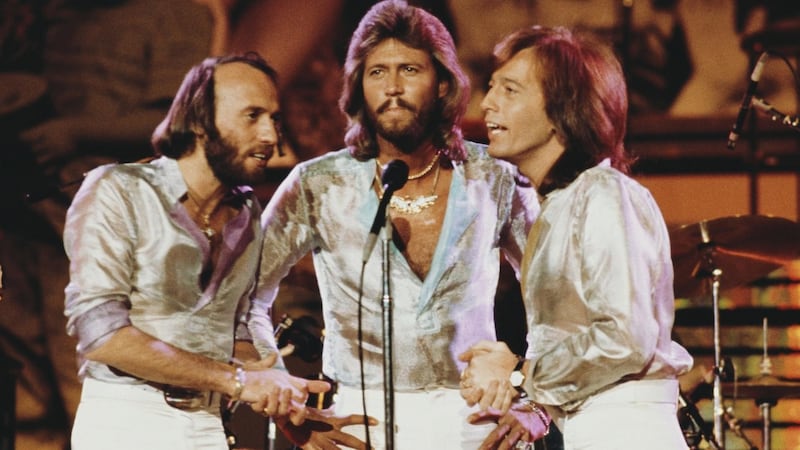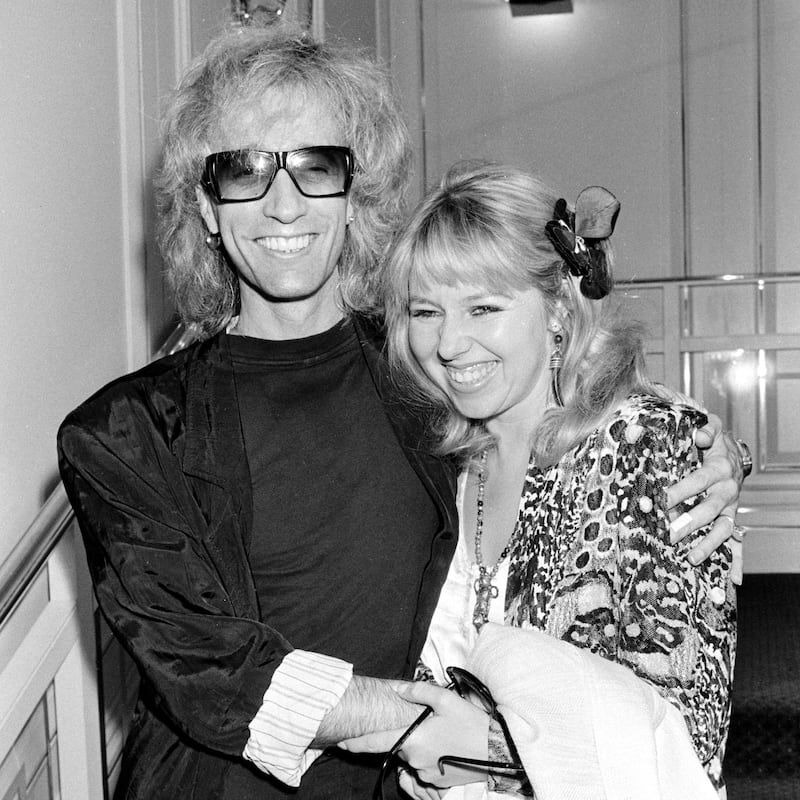Maybe it was the notorious moment in 1997 when, after a barrage of jokey insults from Clive Anderson, the Bee Gees walked out of his chatshow in the middle of an interview. Or maybe it was the fabulously bouffant hair that fluffed defiantly against the punk era. But the brothers Gibb ought to have been cooler.
Writing in The Guardian shortly after the 2003 death of Maurice Gibb, Alexis Petridis railed against the patronising tone found in several obituaries: "They noted the Bee Gees' enormous success, chuckled at their clothes, and mentioned their fraternal bickering and substance abuse. Yet they barely mentioned the music."
Robin Gibb’s death, in 2012, following a lengthy battle with liver and colon cancer, was met with similarly condescending notices.
A new documentary, The Bee Gees: How Can You Mend a Broken Heart, chronicles the band’s extraordinary career, excavating the years before and after their stint as the “kings of disco”, and, in doing so, upending the historical pigeonholing of the brothers Gibb as glitterball kings.
"I remember them when I was growing up in England because I remember them on Top of the Pops, which is no longer going at the BBC but which was a very important show," says the film's producer, Nigel Sinclair. "I think they first appeared with [the song] Massachusetts. Which was number one. So I lived through the first phase of their career, which nobody in America really knows about."
Together with their older brother Barry, the Gibb twins honed three-part vocal harmonies and began performing as a precocious skiffle act
Massachusetts may have distinguished the band as – to quote their manager Robert Stigwood – "the most significant new musical talent of 1967", but the brothers Gibb were hardly new to music. Robin and Maurice were born December 22nd, 1949, on the Isle of Man. Their father, Hugh, was a drummer and big-band leader. Growing up in Manchester and later Australia, the boys listened to and emulated the harmonies of the Mills Brothers.
"That was one of her early challenges in making this film," says the director of How Can You Mend a Broken Heart, Frank Marshall. "It just didn't start in one place. Their story goes all over the place. They went to Australia, but then they came back, and then they went to Miami. So we were trying to tell all that and not make it confusing. A lot of people think they're Australian, but they're not."
Together with their older brother Barry (born 1946), the Gibb twins honed three-part vocal harmonies and began performing as a precocious skiffle act. An early, experimental album – The Bee Gees Sing and Play 14 Barry Gibb Songs – yielded several Australian hits and awards, and reveals a band hopping between genres while revelling in their respective vocal parts.
As Noel Gallagher, one of several famous siblings featured in How Can You Mend a Broken Heart, notes: "When you've got brothers singing it's like an instrument that nobody else can buy."
Returning to the UK, the early post-Merseyside incarnation of Bee Gees found success with To Love Somebody (originally written for Otis Redding before his untimely death), I Started a Joke, and I’ve Got to Get a Message to You. Something like Beatlemania broke out wherever they appeared.
“I had six Rolls-Royces before I was 21,” Maurice said in an interview before his death. “I don’t know where they are now.”
'Try to tell the kids in the '70s who were screaming to the Bee Gees that their music was just The Beatles redone,' John Lennon said
Those early Bee Gees records found great favour with Noel Gallagher and John Lennon. "Try to tell the kids in the '70s who were screaming to the Bee Gees that their music was just The Beatles redone," said Lennon in a 1980 interview. "There is nothing wrong with the Bee Gees. They do a damn good job. There was nothing else going on then."
It was, however, the band's disco years that would scare up most of their 110 million record sales and secure their place among The Beatles, Elvis Presley, Michael Jackson and Paul McCartney in the top five of the most successful recording artists of all time.
In the months after the release of the 1977 movie Saturday Night Fever, seven songs written by the brothers held the No 1 position in the US charts for 27 of 37 consecutive weeks: three of their own releases, two for brother and solo artist Andy Gibb, Yvonne Elliman's If I Can't Have You, and Grease, performed by Frankie Valli.
The band were a later addition to the Saturday Night Fever juggernaut; their song Night Fever was already recorded before they were asked to participate. As John Travolta recalls: "The Bee Gees weren't even involved in the movie in the beginning... I was dancing to Stevie Wonder and Boz Scaggs."
It was the band’s suggestion that Robert Stigwood, their manager and the film’s producer, change the film’s title to Saturday Night Fever.
“I remember I was working at Paramount when Saturday Night Fever came to be,” says Frank Marshall, who, as a producer, has presided over most of Steven Spielberg’s films. “What I actually discovered during this documentary was that it was not the case – like I would do with all my movies – that you call somebody up and you say, hey, can you write something some songs for this? It was the complete opposite.”

Dwina Murphy-Gibb recalls the exact moment when, as a young girl growing up in Co Tyrone, she became interested in Irish mythology, a fascination that has spawned a sequence of books about Cormac mac Airt and a druid-inspired cycle of poems.
“Even though my family, way back, came from Wexford during the time of the Famine, they were soup-takers,” says Murphy-Gibb. “So I went to Protestant school in the North. They didn’t teach Irish or anything about the culture. But I was really good friends with a girl that went to the convent. She used to sit beside me on the bus. And one day we exchanged history books and there was a story from Irish mythology in her history book. And I fell in love. I was hooked.”
Her research into ancient Ireland would, she claims, prove handy when she met Robin Gibb, her husband from 1985 until his death.
“It was like being married to the family,” she says. “It gave me some sense of what life must have been like as part of an ancient Irish clan. We had to move as a group. That was quite a thing. No matter where we were going we went together.
“I had never been outside of Ireland and England so travelling the world and getting used to different seasons, when it’s winter at home but summer in Australia, that took some getting used to. I never expected I was going to live in America. But then the family went to Miami.”

That idea of a clan began a central conceit for director Frank Marshall: “When you see our photos after they all ended up in Miami, everyone was there. There are 30 or 40 people in those photos. Because all of the brothers now each other own individual families plus mom and dad and brother Andy. They did everything together. And that differentiated them from any other group.”
While Murphy-Gibb’s favourite band is Clannad, she feels that her husband’s musical performances and compositions share certain folkish attributes with the Donegal outfit.
“I did love the Bee Gees and I loved Robin’s voice from the first time I heard it,” she says. “But I was really into folk music and their music – for me – has the same qualities. They are storytellers. All their songs are stories. I’ve Got to Get a Message to You is about someone walking the last mile on Death Row. Listening to the Bee Gees, it was the first time really I found what I loved about folk in pop.”
They wrote incredibly evocative lyrics, notes Nigel Sinclair. “I remember this strange song, New York Mining Disaster 1941. And at the time we all thought that there really was a disaster in 1941. Their greatest songs have these extraordinary opening lines. ‘Tonight I’m going back to Massachusetts’. And if you look at their opening lines they all set the stage for something.”
While it's possible to think of some solo acts who have reinvented themselves on multiple occasions, no other band has bounced so successfully between Merseybeat, disco, and 80s and 90s synth-pop
Those songwriting skills evolved over some six extraordinary decades. While it’s possible to think of some solo acts, notably Madonna, who have reinvented themselves on multiple occasions, no other band has bounced so successfully between Merseybeat, disco, and 1980s and 1990s synth-pop.
The Gibb brothers, additionally, scored enormous hits for other recording artists, including Woman in Love (for Barbra Streisand), Heartbreaker (Dionne Warwick), Chain Reaction (Diana Ross) and Islands in the Stream (Kenny Rogers and Dolly Parton).
“When you see how successful they were in different areas of music some people might write that up as imitators following trends,” says Sinclair. “But people have said about Barry – specifically [Bee Gees producer] Albhy Galuten has said – that Barry was dialled into the collective unconscious.
“I think they had an instinct for changes in music. They were listening but they were not just imitating, they actually helped create trends. If you listen to the records from the end of the ’80s, they sound like other bands at Live Aid, but by the ’90s they change again to dramatic storytelling.
“There are those who know Staying Alive and they think the Bee Gees are a disco band. But actually, as you see in the film, the Bee Gees are a treasure box with at least three discrete phases of their career ”
The Bee Gees: How Can You Mend a Broken Heart is released on digital platforms on December 14th










